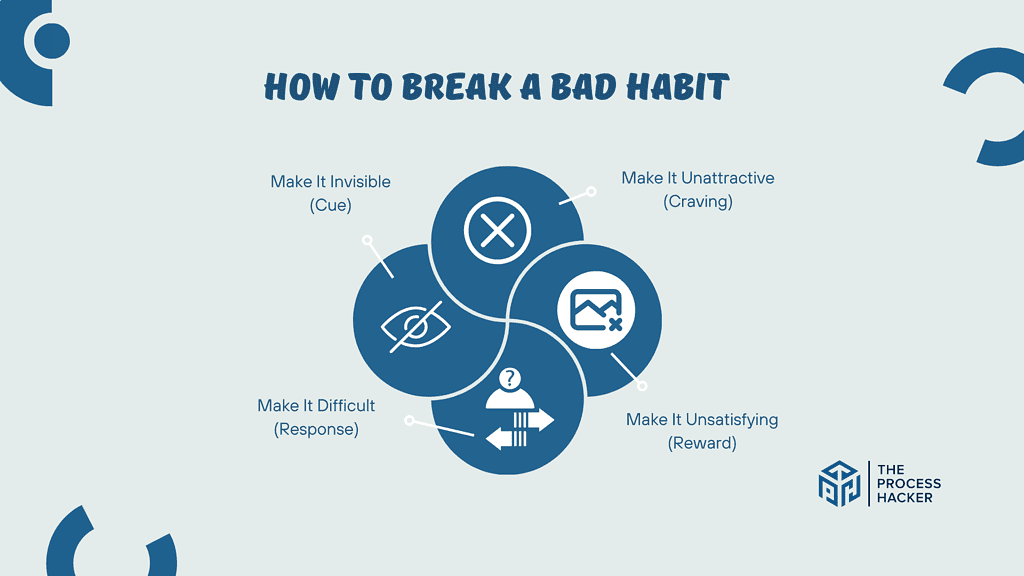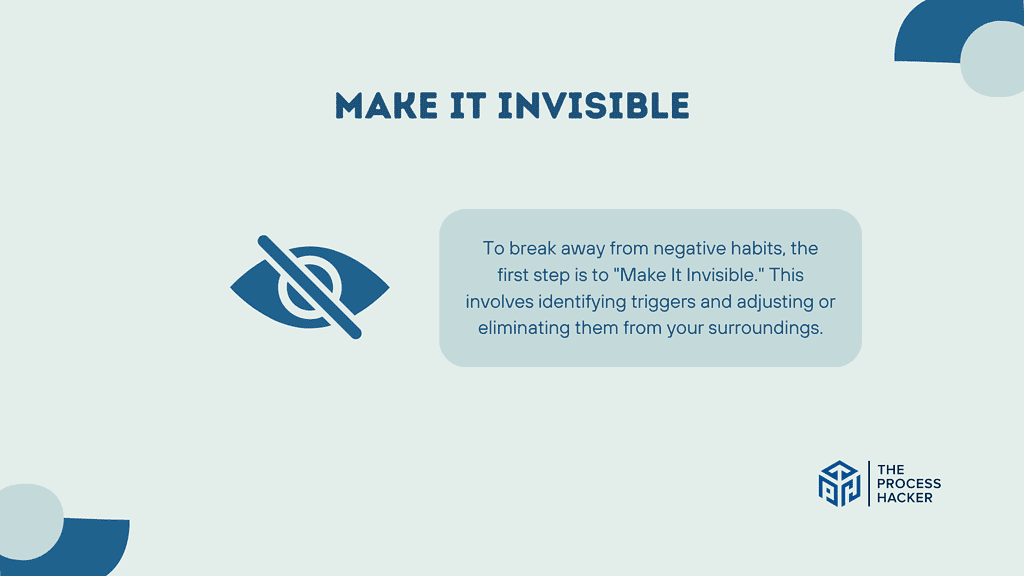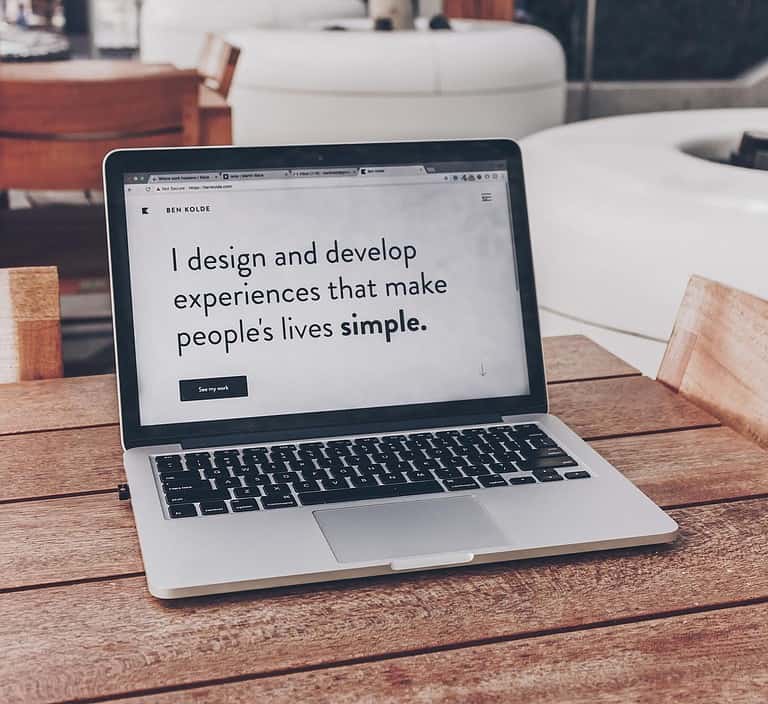How To Break Bad Habits
Stuck in a never-ending cycle of bad habits?
There’s no need to stay stuck any longer! With the help of this guide, you can break those patterns, stop the self-talk, and free yourself from the constant struggle.
Our comprehensive approach covers all the necessary steps for changing your bad behavior so you can be rest assured that you’re on the right track to a healthier life!
Imagine life without procrastinating just to hit deadlines or attend meetings late. Think about replacing those things with activities like yoga, meditation, running, or even learning an instrument instead. The result is creating a healthier and more balanced lifestyle than ever before.
Keep reading this guide for how to break bad habits to free yourself from old bad habits and reclaim control over your life today!
What Is A Habit?
Before diving into how to build bad habits, let’s define what a habit is:
Habit: A habit is simply a behavior repeated enough times to become automatic. It’s something we do without even thinking about it.
But how do we break a harmful habit?
What Is The Habit Loop?
According to James Clear, author of Atomic Habits, it all starts with understanding the habit loop:
The Habit Loop: This feedback loop describes the four steps of habit formation, which are cue, craving, response, and reward:
- Cue – the trigger in your brain that initiates a behavior
- Craving – the motivational force behind each habit
- Response – the actual habit that you performed in thought or action
- Reward – the end goal of every habit that satisfies and teaches you
The “cue triggers a craving, which motivates a response, provides a reward, satisfies the craving, and ultimately becomes associated with the cue.” By understanding this loop, we can break bad ways of life and replace them with good ones.
Why Should You Break Your Bad Habits?
There are many reasons why knowing how to break bad habits is essential. Not only can it improve your daily life, but it can also have a positive impact on your mental health and overall well-being.
By breaking undesirable habits, you’ll be able to achieve your goals and live a healthier, happier life. Here are some of them:
- Bad habits often lead to negative health consequences, such as poor nutrition or lack of exercise.
- They can hinder your productivity and efficiency, preventing you from reaching your full potential.
- Bad habits can impact your mental health, leading to stress, anxiety, or feelings of dissatisfaction.
- They can also strain your relationships, as they often revolve around self-centered behaviors.
The good news is that there is always time to break a bad habit. With the right approach and determination, anyone can replace an unhealthy behavior with a healthier, more productive one. And that’s where my method comes in.
Going through this journey myself, I’ve developed a proven strategy to identify, understand, and ultimately break free from bad habits. This method is practical, easy to follow, and designed to empower you to take control of your life.
Trust me, once you start seeing the positive changes, you’ll realize how powerful breaking undesirable habits can be!
How to Break A Bad Habit

Now, let’s dive into the step-by-step instructions for breaking bad habits. Our unique process involves four key steps from Atomic Habits, which we’ll give exciting names to make them more memorable.
These steps or inverse laws of behavior change include making the habit invisible, unattractive, complicated, and unsatisfying:
- Make It Invisible (Cue) – Identify the cues that trigger the habit and remove them from your environment.
- Make It Unattractive (Craving) – Associate negative feelings with the habit, such as guilt or shame.
- Make It Difficult (Response) – Create obstacles that make it harder to perform the habit.
- Make It Unsatisfying (Reward) – Remove any rewards associated with the habit.
#1) Make It Invisible

The first step in our journey is to “Make It Invisible.” This concept is about identifying the cues or triggers that lead you to engage in your negative habit. For example, if you habitually check your social media accounts as soon as you wake up, doing so instead of stretching or meditating makes it an undesirable practice.
So, how do you “Make It Invisible”? The answer lies in adjusting or eliminating these triggers from your surroundings. In the given scenario, you should keep your phone in another room at night to avoid the temptation of immediate checking in the morning. Then, start your day with a different activity, such as reading a book, walking, or practicing yoga.
Making a habit invisible could also mean physically hiding things associated with the habit. If you’re trying to cut down on social media usage, Cal Newport in Digital Minimalism says to delete your social media accounts, remove the apps from your home screen, or turn off notifications.
The saying “out of sight, out of mind” applies here. Making these triggers less noticeable decreases the likelihood of slipping into your unwanted behavior. It’s just the first step, but it is essential in breaking away from the cycle of negative behaviors.
#2) Make It Unattractive

Next is the step “Make It Unattractive.” This part of the process focuses on changing your mindset about the old and new habit you’re trying to break. The goal is to make the habit seem less appealing, making you less likely to engage.
How do we make a habit unattractive? It’s all about associating negative connotations with the habit. For instance, if you’re trying to cut down on your sugar intake, start thinking about the harmful effects too much sugar can have on your health – weight gain, increased risk of diabetes, tooth decay, and the list goes on.
Visualizing these negative consequences every time you crave something sweet can help deter you from giving in to the craving. Over time, your brain will start associating sugary foods with these negative outcomes, making them less appealing.
Consider writing down the negative impacts of your habit and keeping this list somewhere you can see it regularly. This constant reminder can help reinforce the unattractiveness of the habit.
It’s not about shaming yourself but creating a healthier perspective towards your habits. By learning to see your negative habit as unattractive, you’re taking another significant step towards breaking it for good.
#3) Make It Difficult

Moving onto the third step in our journey, “Make It Difficult.” This strategy involves creating barriers or obstacles that make engaging in your unhealthy habit harder. The idea is simple: the more difficult it is to perform a habit, the less likely you are to do it.
So, how can you make a negative habit seem difficult to engage with? There are several ways to approach this. If you’re trying to reduce your time on social media, you could delete your social media accounts or remove the apps from your phone, requiring you to log in via a web browser whenever you want to check your accounts. This extra step makes the habit less convenient and less appealing.
Another method could be to set up penalties for engaging in the undesirable habit. I like the website, Stickk, for this tip. For example, if you’re trying to quit smoking, you could pledge to donate a certain amount of money on Stickk to a cause you greatly dislike every time you light up a cigarette. The thought of contributing to something you don’t believe in can act as a powerful deterrent.
The goal here isn’t to punish yourself but to create enough friction to make you think twice before engaging in the habit. By making your unhealthy habit challenging to perform, you’re setting yourself up for success in your journey to break it.
#4) Make It Unsatisfying

Finally, we arrive at the last step in our journey, “Make It Unsatisfying.” The principle behind this step is simple: if a habit does not satisfy you, you’re less likely to keep doing it.
So, how can you make your unhealthy ways unsatisfying? One effective way is to implement an accountability system. This could be a friend or family member who knows about your goal to break your undesirable habit and hold you accountable for your actions. They’ll see if you don’t stick to your commitment, making the habit unsatisfying because it disappoints someone else.
Another method is to set up a consequence that will occur if you engage in bad practices. For instance, if you’re trying to stop procrastinating on your work, you might decide that each time you put off a task, you’ll have to wake up an hour earlier the next day to complete it.
The discomfort of losing sleep makes the habit of procrastinating unsatisfying. The idea isn’t to punish yourself excessively but to create a negative consequence that helps deter you from the habit.
Breaking a bad manner is no small feat, but you can significantly increase your chances of success by making it invisible, unattractive, challenging, and unsatisfying. These steps aren’t a quick fix, but with patience and consistency, you’ll find yourself moving closer to your goal.
Key Considerations To Replace A Bad Habit
As we journey towards breaking undesirable behavior, it’s important to remember that this process is not just about stopping a behavior but also about replacing it by building a good habit. This can make the transition more accessible and more sustainable.
For instance, if you’re trying to quit smoking, you might pick up a healthier habit like running or walking when you feel the urge to light up.
Remember, patience is key. Breaking a habit takes time, and there will be setbacks along the way. Don’t beat yourself up if you slip up. Instead, use it as a learning experience to understand what triggered the relapse and how to avoid it. Don’t forget to reward yourself in the process.
Lastly, celebrate your small victories. Even if you’ve just managed to resist unhealthy practices for a day, that’s progress. Rewarding yourself can motivate you to keep going and reinforce your commitment to change.
Taking it to the Next Level: Read Atomic Habits
If you want further strategies and insights into how habits form and change, I highly recommend reading “Atomic Habits” by James Clear. This book delves deeper into the science of habits and offers practical strategies to help you make good habits inevitable and bad practices impossible.
“Atomic Habits” builds on the principles we’ve discussed here, providing a comprehensive guide to understanding how habits work and how to harness their power. The book emphasizes making small changes that add to significant results over time – hence the term ‘atomic’.
Whether trying to break an undesirable habit or build a new one, “Atomic Habits” can provide you with a wealth of knowledge and tools to help you succeed.
So, go ahead, grab a copy, and take your habit-breaking journey to the next level!
Alternatives Methods
Finally, if you need clarification on whether this method suits you, there are alternative methods to breaking bad habits. Some people succeed with mindfulness and meditation, while others prefer to work with a therapist or coach.
Final Thoughts on How to Break Bad Habits
And there you have it – a comprehensive guide on how to break bad habits!
We’ve journeyed through making your bad habits invisible, unattractive, difficult, and unsatisfying. Along the way, we’ve also learned how important it is to replace bad practices with something else, something better, be patient with ourselves, celebrate small victories, and seek further knowledge.
This guide has provided practical steps and insights that will empower you to kick your undesirable habits to the curb and replace them with healthier, more beneficial ones.
Why should you listen to me? I want to equip you with the tools you need to make positive changes in your life. Breaking a habit is a journey, not a destination.
It takes time, effort, and patience. But with these strategies, you’re well on your way to reward and success. Stick with it, and you’ll soon see the fruits of your labor. Good luck!







